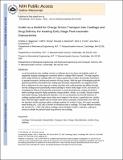Avidin as a model for charge driven transport into cartilage and drug delivery for treating early stage post-traumatic osteoarthritis
Author(s)
Bajpayee, Ambika G.; Wong, Cliff R.; Bawendi, Moungi G.; Grodzinsky, Alan J.; Frank, Eliot
DownloadGrodzinsky_Avidin as a model.pdf (2.452Mb)
PUBLISHER_CC
Publisher with Creative Commons License
Creative Commons Attribution
Terms of use
Metadata
Show full item recordAbstract
Local drug delivery into cartilage remains a challenge due to its dense extracellular matrix of negatively charged proteoglycans enmeshed within a collagen fibril network. The high negative fixed charge density of cartilage offers the unique opportunity to utilize electrostatic interactions to augment transport, binding and retention of drug carriers. With the goal of developing particle-based drug delivery mechanisms for treating post-traumatic osteoarthritis, our objectives were, first, to determine the size range of a variety of solutes that could penetrate and diffuse through normal cartilage and enzymatically treated cartilage to mimic early stages of OA, and second, to investigate the effects of electrostatic interactions on particle partitioning, uptake and binding within cartilage using the highly positively charged protein, Avidin, as a model. Results showed that solutes having a hydrodynamic diameter ≤10 nm can penetrate into the full thickness of cartilage explants while larger sized solutes were trapped in the tissue's superficial zone. Avidin had a 400-fold higher uptake than its neutral same-sized counterpart, NeutrAvidin, and >90% of the absorbed Avidin remained within cartilage explants for at least 15 days. We report reversible, weak binding (K[subscript D] ~ 150 μm) of Avidin to intratissue sites in cartilage. The large effective binding site density (N[subscript T] ~ 2920 μm) within cartilage matrix facilitates Avidin's retention, making its structure suitable for particle based drug delivery into cartilage.
Date issued
2013-10Department
Massachusetts Institute of Technology. Center for Biomedical Engineering; Massachusetts Institute of Technology. Department of Biological Engineering; Massachusetts Institute of Technology. Department of Chemistry; Massachusetts Institute of Technology. Department of Electrical Engineering and Computer Science; Massachusetts Institute of Technology. Department of Mechanical EngineeringJournal
Biomaterials
Publisher
Elsevier
Citation
Bajpayee, Ambika G., Cliff R. Wong, Moungi G. Bawendi, Eliot H. Frank, and Alan J. Grodzinsky. “Avidin as a Model for Charge Driven Transport into Cartilage and Drug Delivery for Treating Early Stage Post-Traumatic Osteoarthritis.” Biomaterials 35, no. 1 (January 2014): 538–549.
Version: Author's final manuscript
ISSN
01429612
1878-5905